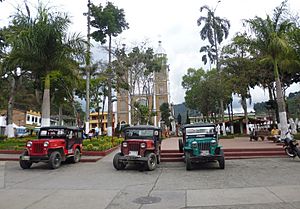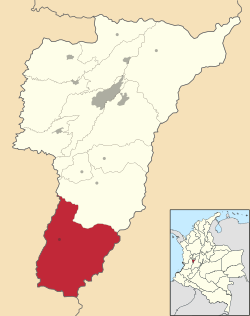Génova, Quindío facts for kids
Quick facts for kids
Génova, Quindío
|
||
|---|---|---|
|
Municipality and town
|
||

Génova Main Square
|
||
|
||

Location of the municipality and town of Génova, Quindío in the Quindío Department of Colombia.
|
||
| Country | ||
| Department | Quindío Department | |
| Area | ||
| • Total | 297.9 km2 (115.0 sq mi) | |
| Elevation | 1,450 m (4,760 ft) | |
| Population
(2023)
|
||
| • Total | 7,726 | |
| Time zone | UTC-5 (Colombia Standard Time) | |
Génova (pronounced HAY-noh-vah) is a town and municipality in the southern part of the Quindío region in Colombia. It is located about 52 kilometers (32 miles) south of Armenia, which is the capital city of the Quindío department.
Génova is part of the famous "Colombian coffee growing axis". This area is so special that UNESCO recognized it as a World Heritage Site in 2011. In 2023, Génova had an estimated population of 7,726 people.
Contents
Exploring Génova's History
Génova was founded by a man named Segundo Henao Patiño. He was also the founder of another town called Calarcá in 1886.
Founding the Town
During a time of conflict called the Thousand Day War, Segundo Henao Patiño heard that some people were in danger. To stay safe, he decided to organize a group of people from Calarcá to explore the mountains to the south.
This group, led by Henao, included many families like Patiño, Ossa, Ospina, and others. They started to settle land along the Gris and Azul rivers. There were already some settlers living near the Gris River.
A New Community Begins
Segundo Henao was well-known because he had helped start Calarcá. All the settlers were excited when he announced his plan to form a new town. They chose him to pick the best spot and design the streets.
Henao chose a place where the Gris and San Juan rivers meet. This land belonged to Luis Ossa. The town was officially founded on October 12, 1903.
Génova's Growth and Status
Génova first became a corregimiento (a type of local district) of Calarcá in 1906. Later, in 1927, it became part of the municipality of Pijao.
Finally, in 1937, Génova became its own separate municipality. This meant it had its own local government. Fución Londoño was the first mayor of Génova.
Génova's Climate
Génova has a subtropical highland climate. This means it has mild temperatures all year round. The average temperature in Génova is about 21°C (70°F).
See also
 In Spanish: Génova (Quindío) para niños
In Spanish: Génova (Quindío) para niños


